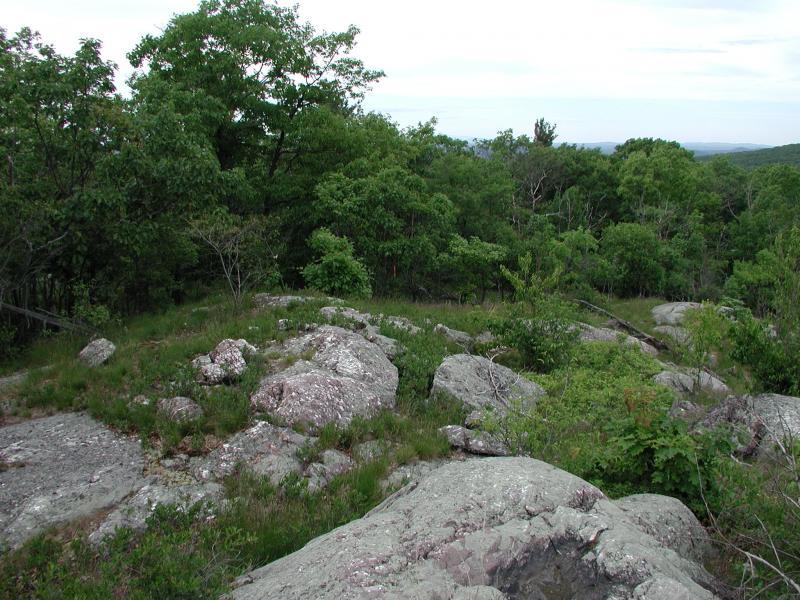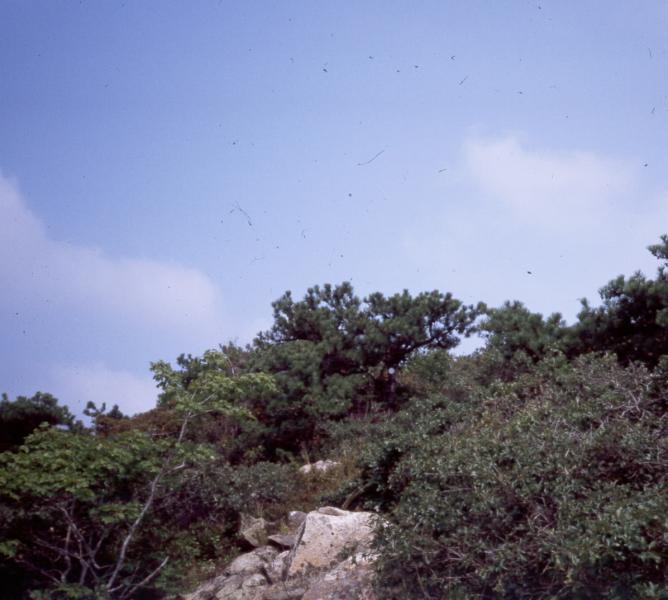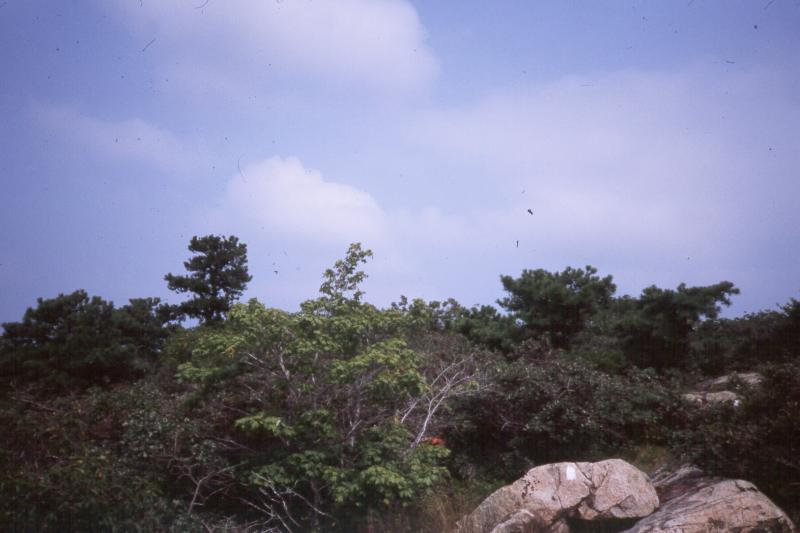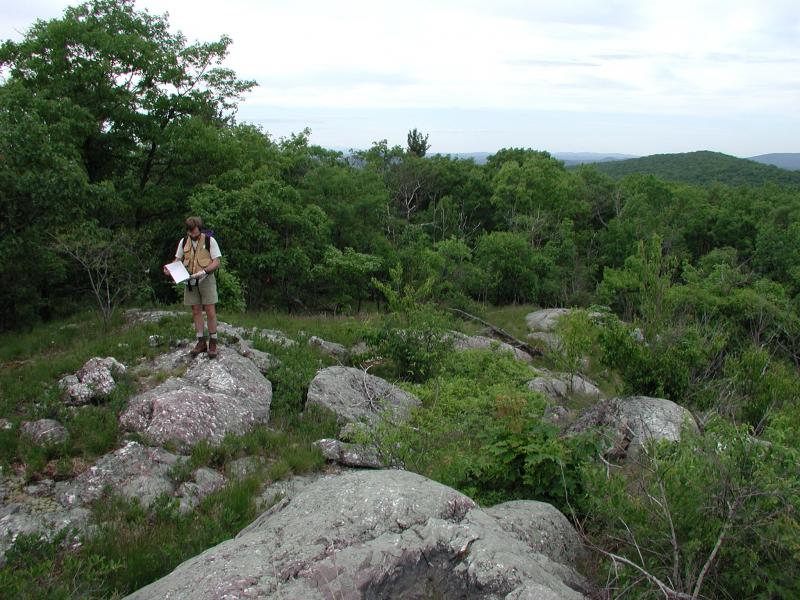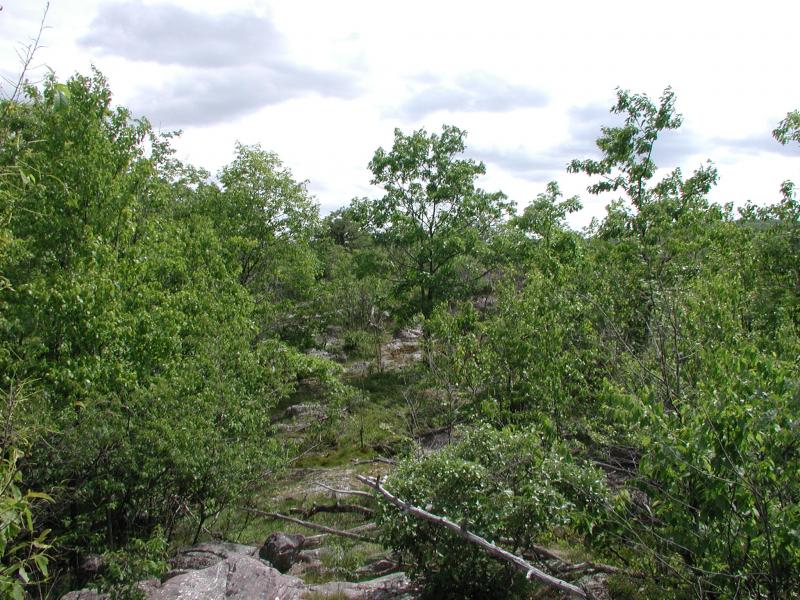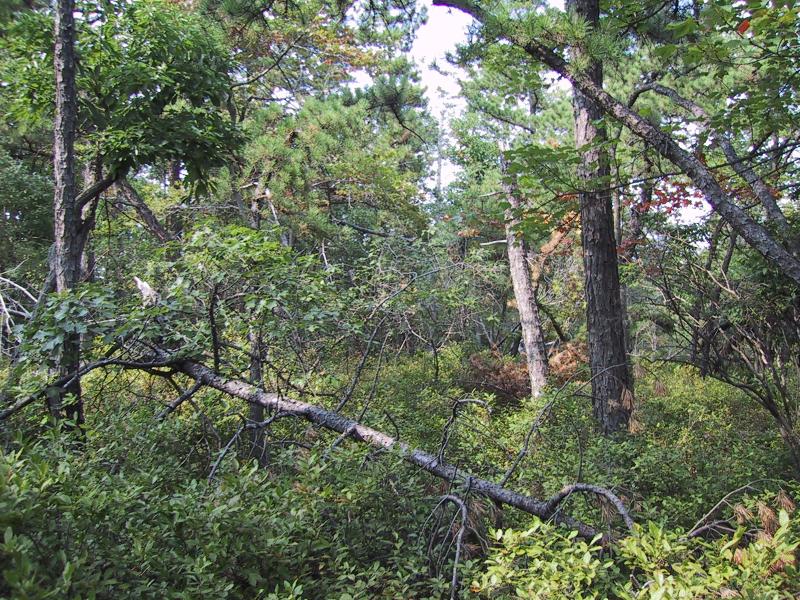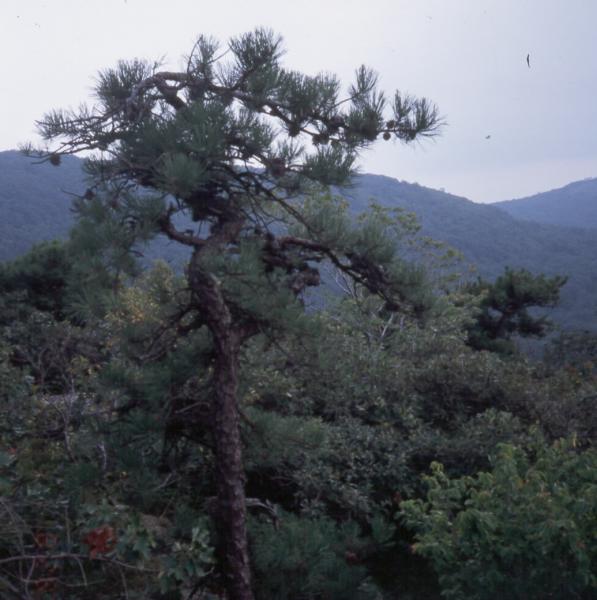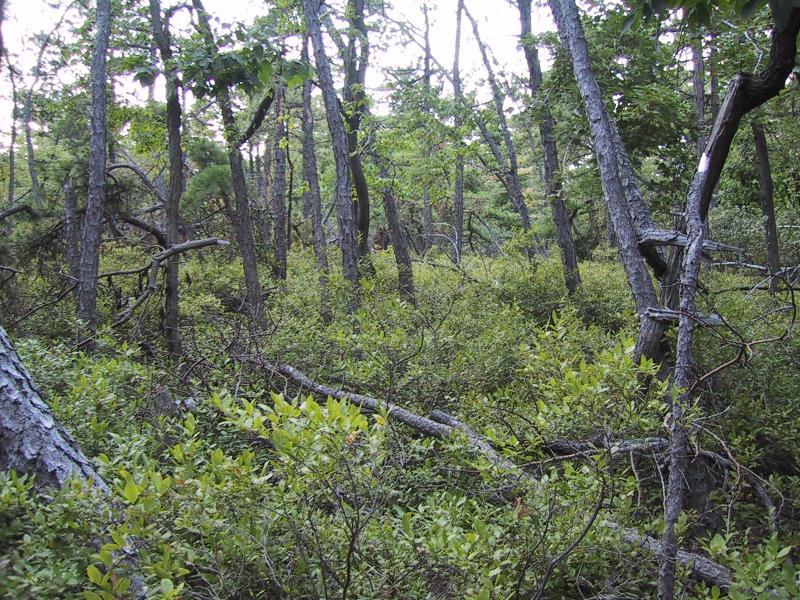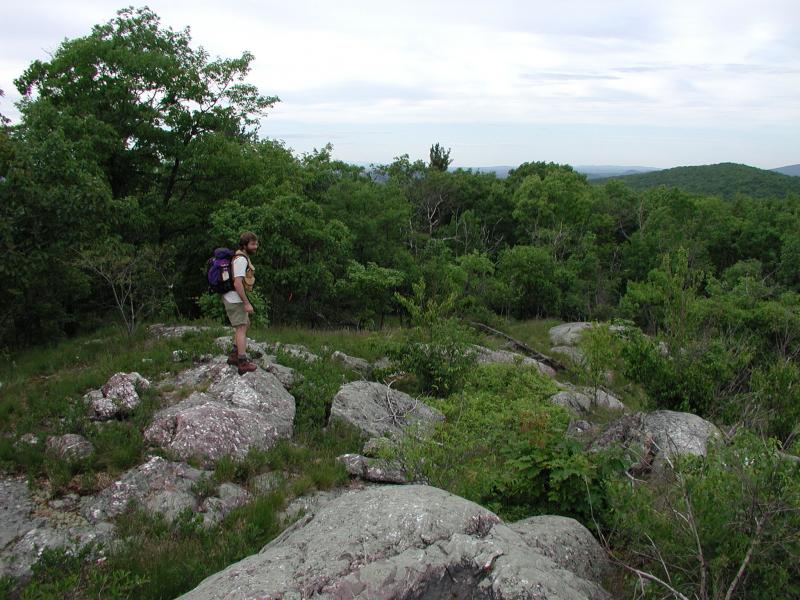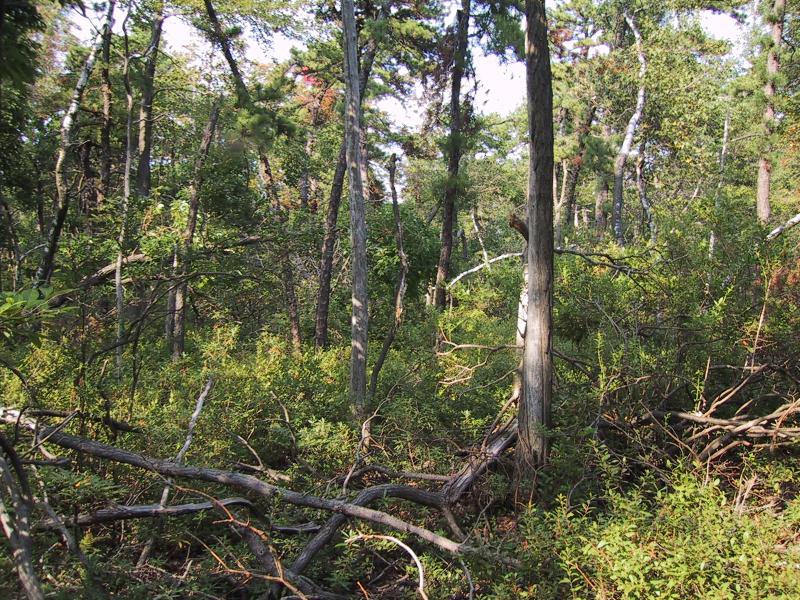Pitch Pine-Oak-Heath Rocky Summit
- System
- Terrestrial
- Subsystem
- Barrens And Woodlands
- State Protection
- Not Listed
Not listed or protected by New York State.
- Federal Protection
- Not Listed
- State Conservation Status Rank
- S3S4
Vulnerable in New York, or Apparently Secure - Vulnerable to disappearing from New York (but not currently imperiled), with relatively few populations or locations, few individuals, and/or restricted range; or uncommon but not rare in New York; may be rare in some parts of the state; possibly some cause for long-term concern due to declines or other factors. More information is needed to assign either S3 or S4.
- Global Conservation Status Rank
- G4
Apparently Secure globally - Uncommon in the world but not rare; usually widespread, but may be rare in some parts of its range; possibly some cause for long-term concern due to declines or other factors.
Summary
Did you know?
Historically, fires of moderate intensity naturally occurred on pitch pine-oak-heath rocky summits every 5 to 25 years, which maintained the character of this community. Without fire, other woody species become more abundant. Depending on the fire regime, this community may be expressed as a mix of pitch pine, oaks, and heath species such as blueberry and huckleberry; a "scrub oak bald" with little pitch pine or heath species; or a "heath bald" with little pitch pine or oak.
State Ranking Justification
Although there may be a few thousand occurrences statewide, there are probably fewer than 100 occurrences left in good condition, and the sizes are often relatively small. Many documented occurrences have good viability and many are protected on public land or private conservation land. This community has a somewhat limited statewide distribution (correlated to slightly acidic to low pH bedrock geology). Most examples are relatively small and disturbed. This community has probably declined substantially from historical numbers and nearly all of the currently documented occurrences are threatened by fire suppression, recreational overuse, and development.
Short-term Trends
The number and acreage of pitch pine-oak-heath rocky summits in New York have probably declined slightly in recent decades due to fire suppression, antenna tower construction, recreational disturbances, and invasive species.
Long-term Trends
The number and acreage of pitch pine-oak-heath rocky summits in New York have probably declined moderately from historical numbers as a result of fire suppression, summit clearing for development, and mining of mineral resources.
Conservation and Management
Threats
Pitch pine-oak-heath rocky summits are threatened by development (especially plans for cellular telephone and radio towers, wind farms, etc.) and trampling by recreational visitors (e.g., mountain bikers, hang-gliders, and hikers). Given the stunted and gnarly growth form of summit trees, the community is only minimally threatened for timber resources. Summits on unprotected land may targeted for mining of mineral resources. Clearing in the adjacent forest may be a threat that provides corridors for invasive plants. Natural fire regimes (e.g., from lightning strikes) may be suppressed in some areas, but are apparently intact at many sites, especially in the Adirondacks. Southern pine beetle (Dendroctonus frontalis) is a bark beetle that infests pine trees, such as pitch pine, white pine, and red pine. Southern pine beetle is native to the southeastern United States, but its range has spread up the east coast to Long Island, New York in 2014. Natural communities dominated or co-dominated by pines would likely be most impacted by southern pine beetle invasion.
Conservation Strategies and Management Practices
Management activities should include the development and implementation of prescribed burn plans at appropriate sites. Fragmenting features such as roads, abandoned tower clearings, and unnecessary trails should be reduced or minimized, and high-impact activities such as mountain biking and hang-gliding should be restricted to trails and least sensitive areas. Prevent the dumping of trash and off-trail trampling at heavily visited summits.
Development and Mitigation Considerations
Soils are very thin within and around this community, and the effect of clearing and construction on soil retention and erosion must be considered prior to any development activities. Similarly, these soils are nutrient-poor, and any soil enrichment contamination (e.g., from septic leach fields or fertilized lawns) of this community can alter community structure and function. The open structure of this community is maintained by fire and presents a fire hazard to existing and proposed development. Unprotected structures located within or near this community are more susceptible to damage from fire.
Inventory Needs
Survey for occurrences statewide to advance documentation and classification of pitch pine-oak-oak-heath rocky summits. A statewide review of pitch pine-oak-heath rocky summits is desirable. Continue searching for large sites in good condition (A- to AB-ranked).
Research Needs
Research the composition of pitch pine-oak-heath rocky summits statewide in order to characterize variations. Collect sufficient plot data to support the recognition of several distinct pitch pine-oak-heath rocky summits based on composition and by ecoregion. Research is needed to confirm the existence of heath-dominated summits (i.e., "heath balds") and oak dominated summits (e.g., "scrub oak balds" or "red oak rocky summits") and to assess these as potential new community types. Research the susceptibilty of this community to southern pine beetle infestation.
Rare Species
- Calamagrostis perplexa (Clausen's Reed Grass) (guide)
- Carex cumulata (Clustered Sedge) (guide)
- Carex merritt-fernaldii (Fernald's Sedge) (guide)
- Carex mesochorea (Midland Sedge) (guide)
- Carex tincta (Tinged Sedge) (guide)
- Carphophis amoenus (Eastern Wormsnake) (guide)
- Catocala herodias gerhardi (Herodias or Pine Barrens Underwing) (guide)
- Cicindela patruela patruela (Northern Barrens Tiger Beetle) (guide)
- Corema conradii (Broom Crowberry) (guide)
- Corydalis aurea (Golden Corydalis) (guide)
- Crotalus horridus (Timber Rattlesnake) (guide)
- Elymus glaucus ssp. glaucus (Blue Wild Rye) (guide)
- Emydoidea blandingii (Blanding's Turtle) (guide)
- Glena cognataria (Blueberry Gray) (guide)
- Haliaeetus leucocephalus (Bald Eagle) (guide)
- Malaxis bayardii (Bayard's Adder's Mouth Orchid) (guide)
- Mononeuria glabra (Appalachian Sandwort) (guide)
- Myotis septentrionalis (Northern Long-eared Bat) (guide)
- Neotoma magister (Allegheny Woodrat) (guide)
- Pinus virginiana (Virginia Pine) (guide)
- Ranunculus micranthus (Small-flowered Buttercup) (guide)
- Sceloporus undulatus (Fence Lizard) (guide)
- Silene caroliniana ssp. pensylvanica (Wild Pink) (guide)
- Solidago racemosa (Riverbank Goldenrod) (guide)
- Speranza exonerata (Barrens Itame) (guide)
- Sympistis dentata (Toothed Apharetra) (guide)
- Zale curema (Black-eyed Zale) (guide)
- Zanclognatha martha (Pine Barrens Zanclognatha) (guide)
Range
New York State Distribution
This community is currently known from the Catskill Peaks of the Appalachian Plateau in Ulster and Greene Counties, the Hudson Valley in Orange and Ulster Counties, the Taconic Highlands in Dutchess County, the Hudson Highlands in Orange and Putnam Counties, and the eastern Adirondack foothills in Washington County.
Global Distribution
The range of this narrowly-defined community, the typical pitch pine-dominated variant, probably spans much of range of pitch pine covering much of the northeastern United States. A red pine-dominated variant is apparently limited to the northeastern U.S. and Great Lakes Basin. The broadly-defined community is estimated to range northeast to Maine, west to Michigan, and south along the Appalachian Mountains through New Jersey and Pennsylvania, possibly to Virginia, North Carolina, Kentucky, and Tennessee.
Best Places to See
- Cranberry Mountain Wildlife Management Area (Putnam County)
- Harriman State Park (Orange County)
- North Mountain Wild Forest, Catskill Park (Greene County)
- Wellesley Island State Park (Jefferson County)
- Catskill Park (Ulster County)
- Lake George Wild Forest, Adirondack Park (Warren County)
- Taconic State Park
- Bear Mountain State Park (Orange, Rockland Counties)
Identification Comments
General Description
A community that occurs on warm, dry, rocky ridgetops and summits where the bedrock is non-calcareous (such as quartzite, sandstone, or schist), and the soils are more or less acidic. The vegetation may be sparse or patchy, with numerous rocky outcrops. This community is broadly defined and includes examples that may lack pines and instead are dominated by scrub oak or heath shrubs; this variation is apparently related to fire regime. Pitch pine-oak-heath rocky summit communities are often surrounded by chestnut oak forest.
Characters Most Useful for Identification
This community occurs on rocky slopes, ridges, or summits. When visiting these dry rocky sites, look for a short shrubby layer of heath species with scattered taller scrub oaks, tree oaks, and pitch pine. Characteristic species include pitch pine (Pinus rigida), chestnut oak (Quercus montana), red oak (Q. rubra), and scarlet oak (Q. coccinea). Other trees may include black cherry (Prunus serotina), red maple (Acer rubrum), gray birch (Betula populifolia), choke-cherry (Prunus virginiana), shadbush (Amelanchier arborea), white pine (Pinus strobus), and a few black gum (Nyssa sylvatica). Characteristic shrubs include scrub oak (Q. ilicifolia), common juniper (Juniperus communis), blueberry (Vaccinium angustifolium, V. pallidum), sweet-fern (Comptonia peregrina), and black huckleberry (Gaylussacia baccata). Other shrubs include highbush blueberry (Vaccinium corymbosum), sheep laurel (Kalmia angustifolia), mountain laurel (Kalmia latifolia), chokeberry (Aronia spp), and deerberry (Vaccinium stamineum). Characteristic herbs include Pennsylvania sedge (Carex pensylvanica), poverty-grass (Danthonia spicata), common hairgrass (Deschampsia flexuosa), three-toothed cinquefoil (Potentilla tridentata), and cow-wheat (Melampyrum lineare). Other herbs include bracken fern (Pteridium aquilinum), wintergreen (Gaultheria procumbens), little bluestem (Schizachyrium scoparium), and pink corydalis (Corydalis sempervirens) Characteristic lichens include various crustose, foliose, and fruticose lichens, such as Cetraria arenaria Cladina spp. and Cladonia spp. Characteristic mosses include hair cap moss (Polytrichum spp.) and pincushion moss (Leucobryum glaucum).
Elevation Range
Known examples of this community have been found at elevations between 10 feet and 3,080 feet.
Best Time to See
Blueberries and huckleberries offer refreshing treats when visiting this community type during midsummer. These heath species also turn vivid colors in early autumn, and contrast well with the evergreen pitch pines.
Pitch Pine-Oak-Heath Rocky Summit Images
Classification
International Vegetation Classification Associations
This New York natural community encompasses all or part of the concept of the following International Vegetation Classification (IVC) natural community associations. These are often described at finer resolution than New York's natural communities. The IVC is developed and maintained by NatureServe.
- Pitch Pine / (Bear Oak) / Black Chokeberry / Wavy Hairgrass Woodland (CEGL006116)
- (Eastern White Pine, Northern Red Oak) / Poverty Oatgrass Acidic Bedrock Scrub Grassland (CEGL005101)
- Northern Red Oak - (Chestnut Oak) / Blueberry species / Wavy Hairgrass Woodland (CEGL006134)
NatureServe Ecological Systems
This New York natural community falls into the following ecological system(s). Ecological systems are often described at a coarser resolution than New York's natural communities and tend to represent clusters of associations found in similar environments. The ecological systems project is developed and maintained by NatureServe.
- Central Appalachian Pine-Oak Rocky Woodland (CES202.600)
- Northern Appalachian-Acadian Rocky Heath Outcrop (CES201.571)
Characteristic Species
-
Trees > 5m
- Acer rubrum var. rubrum (common red maple)
- Betula populifolia (gray birch)
- Nyssa sylvatica (black-gum, sour-gum)
- Pinus rigida (pitch pine)
- Pinus strobus (white pine)
- Prunus serotina var. serotina (wild black cherry)
- Quercus coccinea (scarlet oak)
- Quercus montana (chestnut oak)
- Quercus rubra (northern red oak)
-
Shrubs 2 - 5m
- Juniperus communis var. depressa (American common juniper, ground juniper)
- Kalmia latifolia (mountain laurel)
- Quercus ilicifolia (scrub oak, bear oak)
-
Shrubs < 2m
- Comptonia peregrina (sweet-fern)
- Gaylussacia baccata (black huckleberry)
- Vaccinium angustifolium (common lowbush blueberry)
- Vaccinium pallidum (hillside blueberry)
-
Herbs
- Avenella flexuosa (common hair grass)
- Capnoides sempervirens (rock-harlequin, pink-corydalis)
- Carex pensylvanica (Pennsylvania sedge)
- Danthonia spicata (poverty grass)
- Pteridium aquilinum ssp. latiusculum (eastern bracken fern)
- Schizachyrium scoparium var. scoparium (little bluestem)
- Sibbaldia tridentata (three-toothed cinquefoil)
Similar Ecological Communities
- Dwarf pine ridges
(guide)
Dwarf pine ridges have dwarfed pitch pine stands. Pitch pine stands that have mature trees less than 16 feet tall are generally classified as dwarf pine ridges, while stands on ridges that have taller trees are classfied as pitch pine-oak-heath rocky summits.
- Pitch pine-oak-heath woodland
(guide)
Pitch pine-oak-heath woodland occurs on well-drained sandy soils in the pine barrens regions of the coastal plain. Pitch pine-oak-heath rocky summit, in contrast, occurs further inland on rocky soils (and often with rocky outcrops).
- Red pine rocky summit
(guide)
While both communities occur on non-calcareous bedrock and have a heath component, pitch pine-oak-heath rocky summits have pitch pine, various tree oak species, and scrub oak compared to red pine rocky summits that are dominated by red pine with lesser amounts of white pine and red oak. Scrub oak is not characteristic of red pine rocky summits.
- Rocky summit grassland
(guide)
Rocky summit grasslands occur in similar locations as pitch pine-oak-heath rocky summits, but they have fewer woody plants and a higher percent cover of grasses, sedges, and forbs.
Vegetation
Percent cover
This figure helps visualize the structure and "look" or "feel" of a typical Pitch Pine-Oak-Heath Rocky Summit. Each bar represents the amount of "coverage" for all the species growing at that height. Because layers overlap (shrubs may grow under trees, for example), the shaded regions can add up to more than 100%.
Additional Resources
References
Edinger, G. J., D. J. Evans, S. Gebauer, T. G. Howard, D. M. Hunt, and A. M. Olivero (editors). 2014. Ecological Communities of New York State. Second Edition. A revised and expanded edition of Carol Reschke’s Ecological Communities of New York State. New York Natural Heritage Program, New York State Department of Environmental Conservation, Albany, NY. https://www.nynhp.org/ecological-communities/
Edinger, Gregory J., D.J. Evans, Shane Gebauer, Timothy G. Howard, David M. Hunt, and Adele M. Olivero (editors). 2002. Ecological Communities of New York State. Second Edition. A revised and expanded edition of Carol Reschke's Ecological Communities of New York State. (Draft for review). New York Natural Heritage Program, New York State Department of Environmental Conservation. Albany, NY. 136 pp.
McVaugh, R. 1958. Flora of the Columbia County area, New York. Bull. 360. New York State Museum and Science Service. University of the State of New York. Albany, NY. 400 pp.
Motzkin, G., D.A. Orwig, and D.R. Foster. 2002. History and dynamics of a ridgetop pitch pine community. Mount Everett, Massachusetts. Harvard Forest Paper No. 25. Harvard Forest, Harvard University, Petersham, MA.
New York Natural Heritage Program. 2024. New York Natural Heritage Program Databases. Albany, NY.
Olsvig, L.S. 1980. A comparative study of northeastern Pine Barrens vegetation. Ph.D. dissertation, Cornell University, Ithaca, NY. 479 pp.
Reschke, Carol. 1990. Ecological communities of New York State. New York Natural Heritage Program, New York State Department of Environmental Conservation. Latham, NY. 96 pp. plus xi.
Selender, M.D. 1980. Increment borings of pitch pine (Pinus rigida Mill., Pinaceae) from sites on the Shawangunk Ridge and the Ramapo Mountains of southeastern New York State: age and growth dynamics. Skenectada 2: 1-9.
Links
About This Guide
Information for this guide was last updated on: November 10, 2023
Please cite this page as:
New York Natural Heritage Program. 2024.
Online Conservation Guide for
Pitch pine-oak-heath rocky summit.
Available from: https://guides.nynhp.org/pitch-pine-oak-heath-rocky-summit/.
Accessed April 16, 2024.
